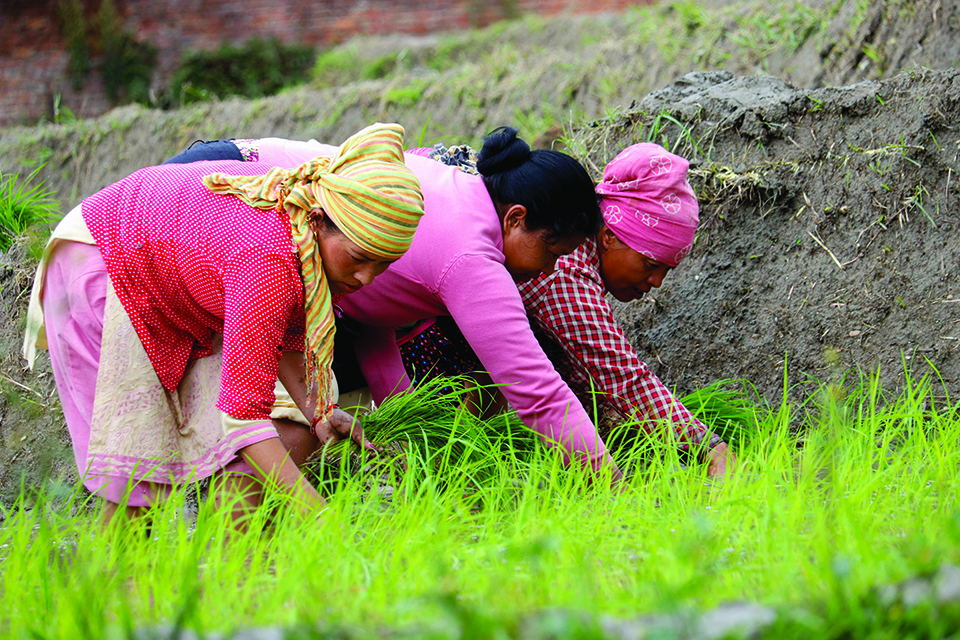
OR
NEPAL-INDIA AGRICULTURE COOPERATION

Nepal should seek Indian support in seed production and marketing, agriculture mechanization and development of agriculture-related infrastructure
Realizing the critical importance and contribution of agriculture for sustainable development, prime ministers of Nepal and India have agreed to give a fresh momentum to bilateral cooperation in agricultural sector and decided to launch a New Partnership in Agriculture. This development has come after Nepali Prime Minister K P Oli’s visit to India and his Indian counterpart Narendra Modi’s Nepal visit two months ago.
The partnership is to be anchored by agriculture ministers of the two countries focusing on collaborative projects in agricultural education, research and development. In this context, the Minister for Agriculture, Land Management and Cooperatives, Chakra Pani Khanal visited India recently and made half a dozen understandings with his Indian counterpart in New Delhi. But priority areas of interest have not been properly identified.
Unanswered questions
As such, this raises several questions. What type of cooperation are we looking for agriculture development in Nepal? Do we need to sign Memorandum of Understanding (MoU) at ministerial level for training 20 farmers in Gajiyabad of Uttar Pradesh in organic farming? Does Nepal need foreign support for promoting organic farming? Does it help ensure food security in Nepal?
A part of the understanding concerns granting “deemed status” to Nepal Agricultural Research Council (NARC) and develop it into an agriculture university. It means NARC will have all the features of a university, though with limited courses. It will no longer be dependent on affiliations to conduct examinations and award certificates. It will become competent to set its own exam papers and award its own certificates. That is good but a question remains: Does Nepal need another agriculture university while we already have a separate Agricultural and Forestry University?
A number of understanding signed with India on June 19, 2018 include Indian support for the development of tea sector, removing trade hurdles through policy measures, formation of joint working group to resolve the issues related to imports and exports of agricultural goods between the two countries, mutual recognition of inspection, testing and certification system, opening of quarantine posts in two locations in the eastern and western parts of Nepal and arrangement for supply of fertilizers among others. No doubt, these are important initiatives for enhancing agricultural production and productivity but they not enough.
Areas of cooperation
Nepal should seek Indian support in areas such as joint venture in seed production and marketing, agriculture mechanization, development of agriculture related infrastructure, such as irrigation facilities, agriculture roads, storage facilities and market infrastructure and support in high-tech agriculture.
In order to increase production and productivity, foreign investment should be concentrated on production and marketing of quality seed. Use of good quality seeds is one of the prerequisites to increase crop production. These need to be made available on time at reasonable prices for the farmers. Seed supply system in Nepal is not reliable and farmers have always complained about unavailability of quality seeds. Nepal is lagging behind in conserving and utilizing diverse genetic resources and producing their seeds and coordinating actors for smooth flow of seeds along the value chain. As a result, Nepali market is gripped with imported seed business leading to rising seed import.
The National Seed Vision has been prepared and incorporated in Agriculture Development Strategy (ADS) to fulfill the gaps that had prevailed in the seed sector in the past. Through its implementation in perfect harmony with the ADS, the seed vision is expected to contribute to production of wide range of crop seeds so that our seed industry would become self-reliant and the national interest of substituting import and promoting export would be safeguarded.
The GP Pant University of Agriculture and Technology (GBPUAT), which has made valuable contribution in modernization of agriculture sector, is situated in Uttarakhand, right next to Nepal. The area where it works has geographical conditions similar to that of Nepal. The seed production centre and integrated farming model established in this university are noteworthy. The first priority area of partnership with India should be the development of a sound seed industry in Nepal.
Agriculture in Nepal is heavily dependent on human and animal power which constitutes 79 percent of the total farm power, while mechanical sources contribute only 21 percent. This is one of the factors responsible for high cost of production and lack of people’s attraction toward farming. Furthermore, rising outmigration of rural youths has posed a challenge in Nepali farming. Agricultural mechanization, which includes improvement of simple farm tools and implements like sickle and hoe to use of tractors, reapers, combine harvesters etc, has become the need of the day.
Lack of financial capital, unavailability of machines and their spare parts, lack of technical and safety standards, poor condition of local agricultural machinery fabricators, and weak research and extension support have constrained mechanization of agriculture in Nepal. Appropriate measures should be taken to address these challenges.
First of all, efforts should be made to improve traditional implements and tools that are in use. The use of such tools has been handed down from generations without any modification. As agriculture is feminizing these days due to male-labor shortage, special attention needs to be given to improve those tools and implements that are commonly used by women.
Indian experience with agricultural mechanization has witnessed marked success over the past few decades. Indian experience in agriculture mechanization can help us identify alternative approaches and develop effective mechanization programs in Nepal.
Currently there is limited and declining public funding for the development of agriculture related infrastructures like irrigation facilities, agriculture roads, storage facilities, cold storages and market infrastructures. Experiences of the neighboring countries show that commercialization of agriculture is possible only when it is supported by the investment on these basic infrastructures. Thus foreign aid, including Indian aid, should be diverted to agriculture infrastructure development needs. We can use these aids to establish Agriculture Knowledge Centers (AKCs) in local units. Addressing climate change impacts, mutual cooperation on agricultural research, germ plasm exchange and human resource development should be other priorities.
bhairabr@gmail.com
You May Like This

Work Together, Grow Together
The number of start-ups and entrepreneurs has mushroomed in the Kathmandu Valley in recent years. Regardless of how unrealistic and... Read More...

CPN-UML, MC to mark 69 years of communist party together tomorrow
KATHMANDU, April 21: CPN-UML and CPN-MC will jointly mark 69 years of Communist Party of Nepal together on Sunday. ... Read More...

FA chairman suggests gay players could come out together
The chairman of the English FA says he has spoken to gay players about providing more support and helping them... Read More...



Just In
- World Malaria Day: Foreign returnees more susceptible to the vector-borne disease
- MoEST seeks EC’s help in identifying teachers linked to political parties
- 70 community and national forests affected by fire in Parbat till Wednesday
- NEPSE loses 3.24 points, while daily turnover inclines to Rs 2.36 billion
- Pak Embassy awards scholarships to 180 Nepali students
- President Paudel approves mobilization of army personnel for by-elections security
- Bhajang and Ilam by-elections: 69 polling stations classified as ‘highly sensitive’
- Karnali CM Kandel secures vote of confidence
















Leave A Comment